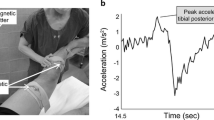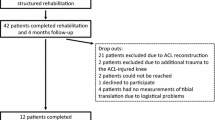Abstract
Purpose
Laximeters were designed to diagnose an anterior cruciate ligament (ACL) deficient knee, but their use has now focused on providing an objective assessment of the anterior translation (AT) of an intact and ACL-reconstructed knee. In this study we report the introduction and direct comparison of an automated and computerized AT measurement device, GNRB, with the device previously established by the institute and as the current literature standard, the KT1000.
Methods
A prospective data collection was commenced upon introduction of the GNRB. The measurements of AT in each patient were performed by the same investigator with each device using 134 N applied to both knees, giving a side-to-side difference. The investigators were a sport scientist, a biomechanical engineer and a physiotherapist. Increased AT was defined as a difference > 3 mm.
Results
Three investigators performed the measurements in 122 patients, 9.8 (± 1.8) months after ACL reconstruction. Mean AT of the healthy knee was 5.7 mm with KT1000 and 4.4 mm with GNRB (p = 0.002). Mean AT of the ACL reconstructed knee was 7.0 mm with the KT1000 and 5.3 mm with the GNRB (p = 0.037). The KT1000 had a higher variance of results than the GNRB (p < 0.001). There were 25 patients with increased AT measured by KT1000 compared with 12 patients using the GNRB (p < 0.016), with only 5 on both devices.
Conclusions
GNRB has better consistency of results when compared to the KT1000. Both devices lack comparability for detecting increased AT, with the KT1000 recording a side-to-side difference of more than 3 mm in twice as many patients as the GNRB.
Level of evidence
II.







Similar content being viewed by others
References
Beldame J, Mouchel S, Bertiaux S, Adam J-M, Mouilhade F, Roussignol X, Dujardin F (2012) Anterior knee laxity measurement: comparison of passive stress radiographs Telos(®) and “Lerat”, and GNRB(®) arthrometer. Orthop Traumatol Surg Res 98:744–750
Branch TP, Mayr HO, Browne JE, Campbell JC, Stoehr A, Jacobs CA (2010) Instrumented examination of anterior cruciate ligament injuries: minimizing flaws of the manual clinical examination. Arthroscopy 26:997–1004
Cavaignac E, Coulin B, Tscholl P, Nik Mohd Fatmy N, Duthon V, Menetrey J (2017) Is Quadriceps tendon autograft a better choice than hamstring autograft for anterior cruciate ligament reconstruction? A comparative study with a mean follow-up of 3.6 years. Am J Sports Med 45:1326–1332
Collette M, Courville J, Forton M, Gagnière B (2012) Objective evaluation of anterior knee laxity; comparison of the KT-1000 and GNRB® arthrometers. Knee Surg Sports Traumatol Arthrosc 20:2233–2238
Daniel DM, Malcom LL, Losse G, Stone ML, Sachs R, Burks R (1985) Instrumented measurement of anterior laxity of the knee. J Bone Joint Surg Am 67:720–726
Gianotti SM, Marshall SW, Hume PA, Bunt L (2009) Incidence of anterior cruciate ligament injury and other knee ligament injuries: a national population-based study. J Sci Med Sport 12:622–627
Graham GP, Johnson S, Dent CM, Fairclough JA (1991) Comparison of clinical tests and the KT1000 in the diagnosis of anterior cruciate ligament rupture. Br J Sports Med 25:96–97
Jenny J-Y, Arndt J, Surgery-France CAO (2013) Anterior knee laxity measurement using stress radiographs and the GNRB(®) system versus intraoperative navigation. Orthop Traumatol Surg Res 99:S297–300
Jenny J-Y, Puliero B, Schockmel G, Harnoist S, Clavert P (2017) Experimental validation of the GNRB® for measuring anterior tibial translation. Orthop Traumatol Surg Res 103:363–366
Klasan A, Putnis SE, Kandhari V, Oshima T, Fritsch BA, Parker DA (2019) Healthy knee KT1000 measurements of anterior tibial translation have significant variation. Knee Surg Sports Traumatol Arthrosc. https://doi.org/10.1007/s00167-019-05768-w
Klouche S, Lefevre N, Cascua S, Herman S, Gerometta A, Bohu Y (2015) Diagnostic value of the GNRB ® in relation to pressure load for complete ACL tears: a prospective case-control study of 118 subjects. Orthop Traumatol Surg Res 101:297–300
Lefevre N, Bohu Y, Naouri JF, Klouche S, Herman S (2014) Validity of GNRB® arthrometer compared to TelosTM in the assessment of partial anterior cruciate ligament tears. Knee Surg Sports Traumatol Arthrosc 22:285–290
Lin J-H, McGorry RW, Maynard W (2013) One-handed standing pull strength in different postures: normative data. Appl Ergon 44:603–608
Mouarbes D, Cavaignac E, Chiron P, Bérard E, Murgier J (2018) Evaluation of reproducibility of robotic knee testing device (GNRB) on 60 healthy knees. J Orthop 15:94–98
Murgier J, Béranger JS, Boisrenoult P, Steltzlen C, Pujol N (2018) Prospective comparative study of knee laxity with four different methods in anterior cruciate ligament tears. Int Orthop 42:1845–1851
Robert H, Nouveau S, Gageot S, Gagnière B (2009) A new knee arthrometer, the GNRB: experience in ACL complete and partial tears. Orthop Traumatol Surg Res 95:171–176
Rohman EM, Macalena JA (2016) Anterior cruciate ligament assessment using arthrometry and stress imaging. Curr Rev Musculoskelet Med 9:130–138
Ryu SM, Na HD, Shon OJ (2018) Diagnostic tools for acute anterior cruciate ligament injury: GNRB, Lachman test, and telos. Knee Surg Relat Res 30:121–127
Schliemann B, Lenschow S, Domnick C, Herbort M, Häberli J, Schulze M, Wähnert D, Raschke MJ, Kösters C (2017) Knee joint kinematics after dynamic intraligamentary stabilization: cadaveric study on a novel anterior cruciate ligament repair technique. Knee Surg Sports Traumatol Arthrosc 25:1184–1190
Smith CD, Scarf D (2017) Spacing repetitions over long timescales: a review and a reconsolidation explanation. Front Psychol 8:962
Sundemo D, Sernert N, Kartus J, Hamrin Senorski E, Svantesson E, Karlsson J, Samuelsson K (2018) Increased postoperative manual knee laxity at 2 years results in inferior long-term subjective outcome after anterior cruciate ligament reconstruction. Am J Sports Med 46:2632–2645
Turner DA, Prodromos CC, Petasnick JP, Clark JW (1985) Acute injury of the ligaments of the knee: magnetic resonance evaluation. Radiology 154:717–722
Tyler TF, McHugh MP, Gleim GW, Nicholas SJ (1999) Association of KT-1000 measurements with clinical tests of knee stability 1 year following anterior cruciate ligament reconstruction. J Orthop Sports Phys Ther 29:540–545
Vauhnik R, Morrissey MC, Perme MP, Sevsek F, Rugelj D (2014) Inter-rater reliability of the GNRB® knee arthrometer. Knee 21:541–543
Vauhnik R, Perme MP, Barcellona MG, Rugelj D, Morrissey MC, Sevsek F (2013) Robotic knee laxity testing: reliability and normative data. Knee 20:250–255
Wautier D, Thienpont E (2017) Changes in anteroposterior stability and proprioception after different types of knee arthroplasty. Knee Surg Sports Traumatol Arthrosc 25:1792–1800
Wiertsema SH, van Hooff HJA, Migchelsen LAA, Steultjens MPM (2008) Reliability of the KT1000 arthrometer and the Lachman test in patients with an ACL rupture. Knee 15:107–110
Zhu M, Li S, Su Z, Zhou X, Peng P, Li J, Wang J, Lin L (2018) Tibial tunnel placement in anatomic anterior cruciate ligament reconstruction: a comparison study of outcomes between patient-specific drill template versus conventional arthroscopic techniques. Arch Orthop Trauma Surg 138:515–525
Zlotnicki JP, Naendrup J-H, Ferrer GA, Debski RE (2016) Basic biomechanic principles of knee instability. Curr Rev Musculoskelet Med 9:114–122
Funding
No funding was received for this study.
Author information
Authors and Affiliations
Contributions
AK and SP conceptualized the study, AK, SP, VK and TO gathered the data. AK analysed the data. AK and DP interpreted the data. AK and SP drafted the manuscript, VK, TO and DP revised it. All authors have given approval for the final version of the manuscript. All authors agree to be accountable for all aspects of the work in ensuring that questions related to the accuracy or integrity of any part of the work are appropriately investigated and resolved.
Corresponding author
Ethics declarations
Conflict of interest
David Parker is has been paid for presentations by Arthrex and Smith and Nephew. He is a consultant of Arthrex and Global. He holds stocks in 360 Knee Systems and Trium. All other authors have no conflicts to declare.
Ethical approval
Ethical approval for the prospective data collection was obtained from the North Sydney Local Health District (HREC/17/HAWKE/140).
Additional information
Publisher's Note
Springer Nature remains neutral with regard to jurisdictional claims in published maps and institutional affiliations.
The research has been performed at the Sydney Orthopaedic Research Institute.
Electronic supplementary material
Below is the link to the electronic supplementary material.
Rights and permissions
About this article
Cite this article
Klasan, A., Putnis, S.E., Kandhari, V. et al. Anterior knee translation measurements after ACL reconstruction are influenced by the type of laximeter used. Knee Surg Sports Traumatol Arthrosc 28, 3639–3646 (2020). https://doi.org/10.1007/s00167-020-05950-5
Received:
Accepted:
Published:
Issue Date:
DOI: https://doi.org/10.1007/s00167-020-05950-5




